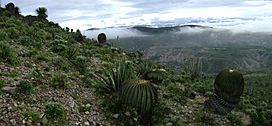Tehuacán Valley matorral facts for kids
Quick facts for kids Tehuacán Valley matorral |
|
|---|---|

Landscape near San Antonio Texcala, Puebla, Mexico
|
|

Map of the Tehuacán Valley matorral
|
|
| Ecology | |
| Realm | Neotropical |
| Biome | deserts and xeric shrublands |
| Borders | Balsas dry forests, Sierra Madre de Oaxaca pine-oak forests, Sierra Madre del Sur pine-oak forests and Trans-Mexican Volcanic Belt pine-oak forests |
| Geography | |
| Area | 9,842 km2 (3,800 sq mi) |
| Country | Mexico |
| States | Oaxaca, Puebla and Tlaxcala |
| Conservation | |
| Conservation status | Critical/endangered |
| Protected | 1,594 km² (16%) |
The Tehuacán Valley matorral is a special kind of dry, shrubby land found in central Mexico. It's like a desert, but with more bushes and shrubs. This area is known for its unique plants and animals.
The word "matorral" comes from Spanish. It means a place with lots of shrubs, bushes, or thickets. You might also hear it used for similar dry areas in Southern Europe.
Contents
Where is the Tehuacán Valley Matorral Located?
The Tehuacán Valley matorral covers the Tehuacán Valley and other nearby valleys. You can find it in parts of the Mexican states of Tlaxcala, Puebla, and Oaxaca.
This area is quite dry because it sits in a "rain shadow." This means the tall mountains around it block most of the rain. So, it gets much less rain than the areas outside the valley.
Neighboring Natural Areas
The Tehuacán Valley matorral is surrounded by other natural regions. To the northwest, north, and northeast, you'll find the Trans-Mexican Volcanic Belt pine-oak forests. To the east, there are the Sierra Madre de Oaxaca pine-oak forests. Finally, to the southeast, south, and southwest, it borders the Balsas dry forests.
Amazing Plants of the Tehuacán Valley
The Tehuacán Valley matorral is a hotspot for plant life. It has over 2,700 different plant species! About 30% of these plants are endemic, meaning they grow nowhere else in the world.
This region is especially rich in types of Agave (like the plant used to make tequila), Hechtia, Salvia, and many kinds of cactus. The ecoregion has several different plant communities, each with its own unique mix of species.
Animals of the Tehuacán Valley
This dry region is home to a wide variety of birds and bats. There are about 90 different bird species here. Ten of these birds are endemic, meaning they are found only in this valley. Examples include the ocellated thrasher (Toxostoma ocellatum) and the bridled sparrow (Aimorphilla mystacalis).
The Tehuacán Valley also has 34 different species of bats. Sadly, 18 of these bat species are considered endangered, vulnerable, or rare. This means they need special protection to survive.
Protected Areas in the Valley
It's important to protect special places like the Tehuacán Valley matorral. In 2017, it was found that about 1,594 square kilometers of this ecoregion are protected. This is about 16% of the entire area. One major protected area is the Tehuacán-Cuicatlán Biosphere Reserve. These protected areas help keep the unique plants and animals safe for the future.
See also
 In Spanish: Valle de Tehuacán para niños
In Spanish: Valle de Tehuacán para niños
- List of ecoregions in Mexico
- Matorral


